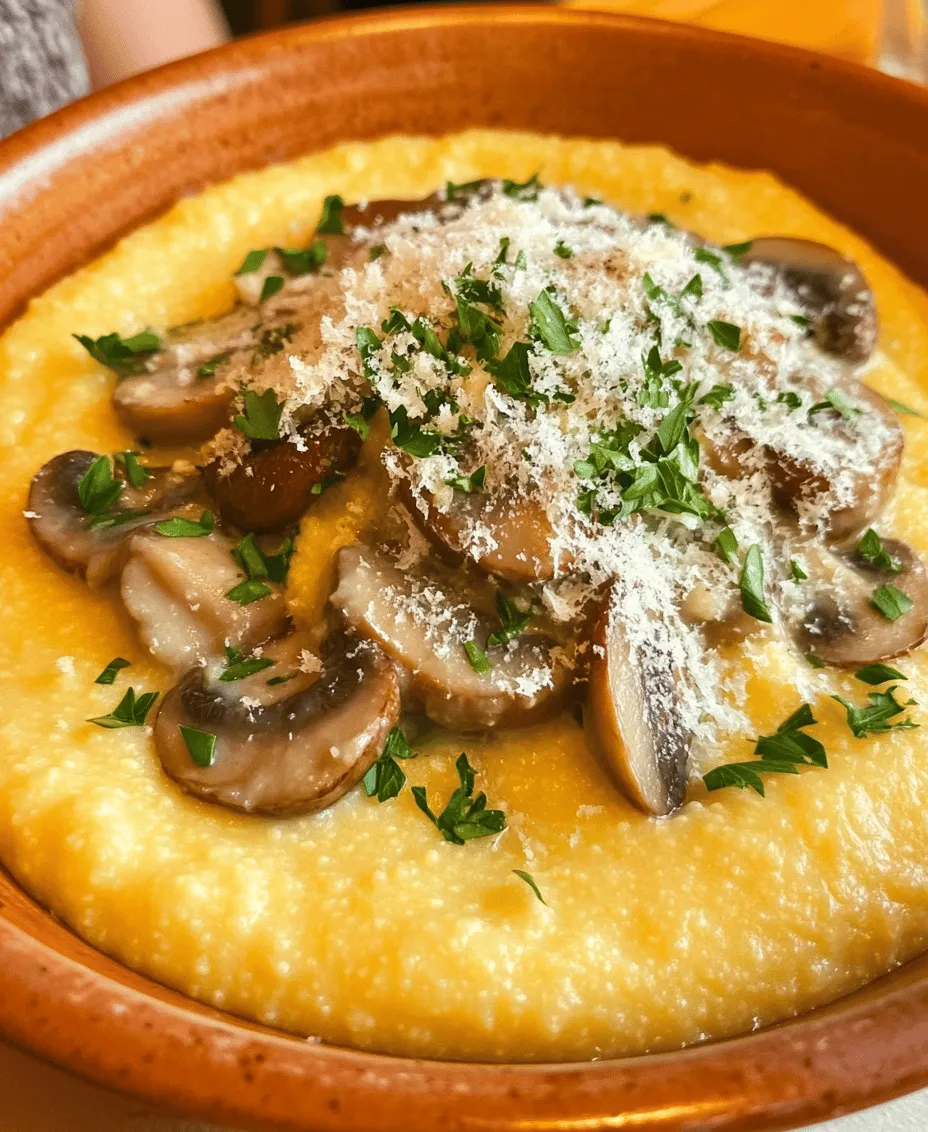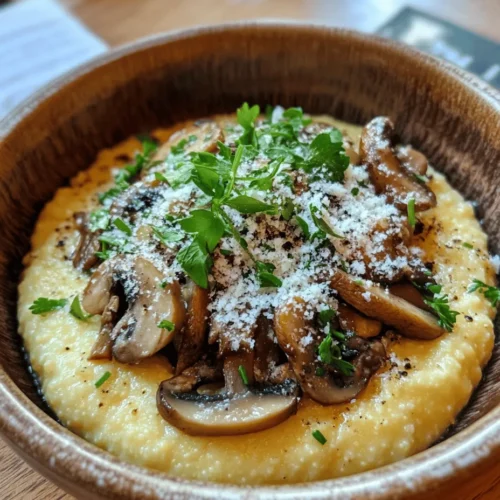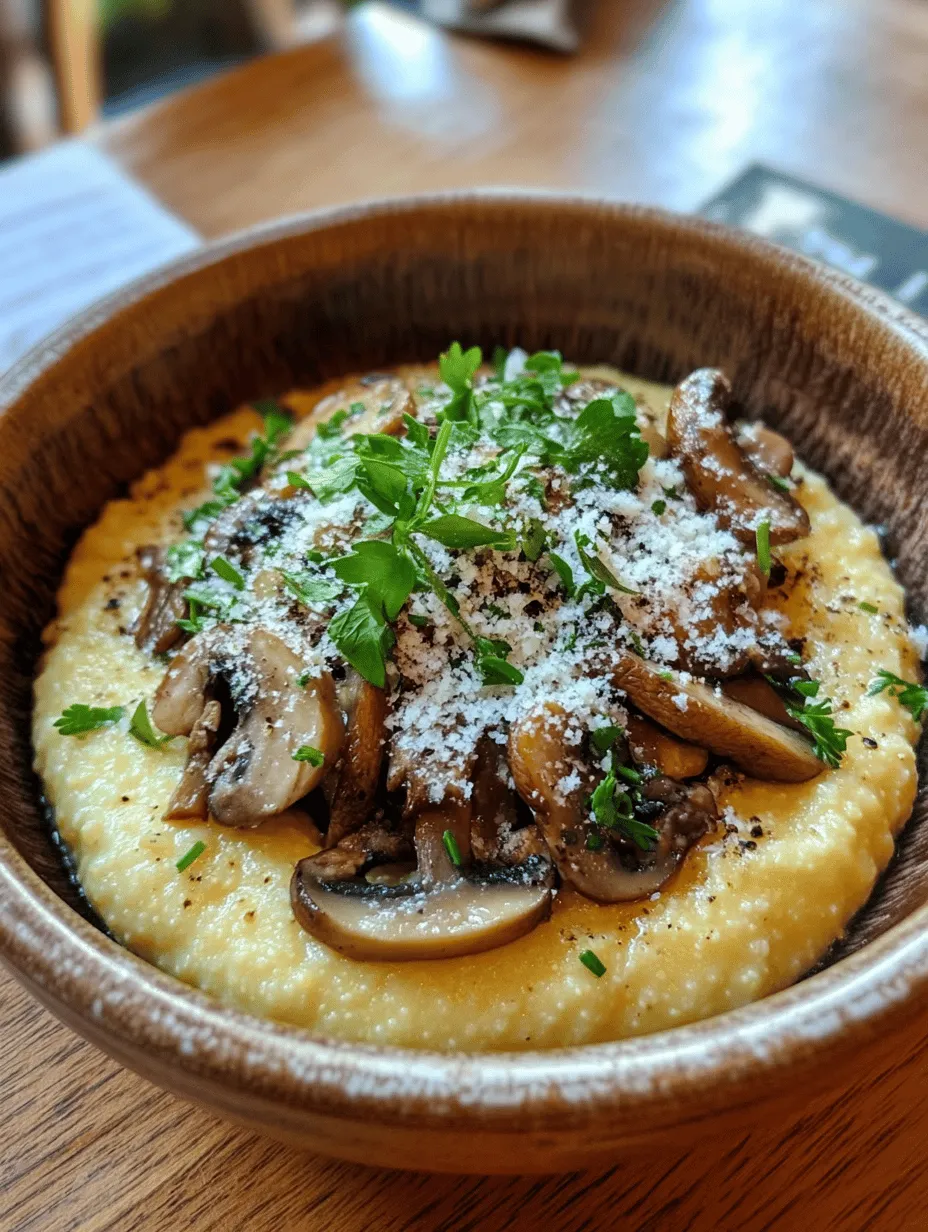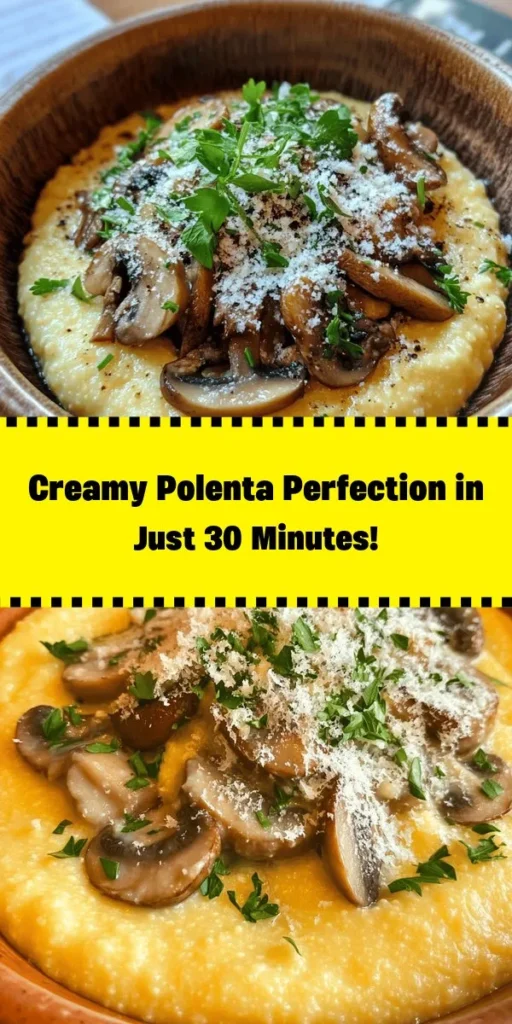Introduction
Polenta is more than just a dish; it is a comforting staple that has graced tables for centuries, particularly in Italian cuisine. Made from ground cornmeal, polenta serves as a versatile base that can be transformed into a variety of meals, ranging from creamy side dishes to hearty entrees. This article aims to guide you through the art of making perfectly creamy polenta – a skill that elevates this humble dish from simple to sensational.
Mastering the technique of cooking polenta is essential for anyone looking to expand their culinary repertoire. The creamy, rich texture of well-cooked polenta can elevate your dishes, making them not only more satisfying but also more flavorful. In this article, we will explore the origins of polenta, its nutritional benefits, key ingredients necessary for achieving that perfect creamy consistency, and provide you with step-by-step instructions on how to make it. Whether you are a seasoned cook or a kitchen novice, you will find valuable insights that will help you create a delicious polenta dish that will impress your family and friends.
Understanding Polenta
Definition and Origin of Polenta
Polenta is a traditional Italian dish made from ground cornmeal, which is boiled in water or broth until it thickens into a creamy or firm consistency. Its roots can be traced back to ancient Rome, where it was made from various grains before corn became the predominant ingredient in the Americas. As corn spread across Europe after the Columbian Exchange, polenta became a beloved staple in many Italian households, especially in the northern regions.
Historically, polenta was considered peasant food, but over time, it has gained popularity and recognition as a versatile and gourmet ingredient. Today, polenta can be served in various ways – soft and creamy, allowed to set and sliced, or even grilled and fried. Its adaptability makes it an excellent canvas for a multitude of flavors and toppings, from savory sauces to fresh herbs.
Different Types of Polenta and Cornmeal
When it comes to polenta, not all cornmeal is created equal. There are several types of cornmeal used to make polenta, each with its texture and flavor profile. The most common types include:
– Coarse Cornmeal: This type is often used for traditional polenta. It has a gritty texture and takes longer to cook, but it yields a heartier, rustic dish.
– Medium Cornmeal: Slightly finer than coarse cornmeal, medium cornmeal cooks more quickly and results in a creamier polenta.
– Fine Cornmeal: This variety produces the smoothest polenta, cooking rapidly to create an ultra-creamy texture, perfect for those who prefer a silkier consistency.
When selecting cornmeal for your polenta, consider your desired texture. For the ultimate creamy polenta experience, medium or fine cornmeal is recommended. Additionally, look for stone-ground cornmeal, which retains more natural flavors and nutrients compared to highly processed varieties.
Nutritional Benefits of Polenta
Polenta is not only delicious but also offers several nutritional benefits. It is gluten-free, making it an excellent option for those with gluten sensitivities or celiac disease. Here are some of the key nutritional highlights of polenta:
– Rich in Carbohydrates: Polenta is a great source of complex carbohydrates, providing energy for your daily activities.
– Low in Calories: Polenta is relatively low in calories, making it a suitable option for those looking to maintain or lose weight.
– Source of Fiber: Depending on the type of cornmeal used, polenta can be a good source of dietary fiber, aiding in digestion and promoting satiety.
– Vitamins and Minerals: Polenta contains essential vitamins and minerals, including B vitamins, magnesium, and phosphorus, contributing to overall health.
With these nutritional benefits, polenta can be a wholesome addition to balanced meals, whether you enjoy it as a side dish or as the star of the plate.
Key Ingredients for Perfectly Creamy Polenta
To achieve the perfect creamy polenta, the quality of your ingredients is crucial. Each component plays a vital role in creating the final dish, contributing to its flavor, texture, and creaminess. Below are the key ingredients you will need:
Polenta (Cornmeal)
The cornerstone of any polenta dish is, of course, the cornmeal itself. As previously mentioned, selecting the right type of cornmeal is essential. For creamy polenta, medium or fine cornmeal is recommended, as it cooks faster and yields a smoother texture. Look for high-quality, stone-ground cornmeal to maximize flavor and nutritional content.
Water vs. Vegetable Stock
The liquid used to cook the polenta greatly impacts its flavor. While water is a straightforward choice, using vegetable stock or broth can infuse your polenta with additional depth and richness. The choice between water and stock can depend on the overall flavor profile you wish to achieve. If you prefer a neutral taste, water will suffice; however, for a more savory dish, vegetable stock is highly recommended.
Role of Salt
Salt is a vital ingredient in polenta not just for seasoning but also for enhancing the overall flavor. Adding salt to the cooking liquid helps to bring out the natural sweetness of the corn. It is advisable to add salt to the water or stock before bringing it to a boil, ensuring that the grains absorb the flavor as they cook. Remember to taste and adjust seasoning towards the end of the cooking process for the best results.
Importance of Butter and Cheese
For that signature creamy texture that polenta is known for, incorporating butter and cheese is essential. Butter adds richness and a velvety mouthfeel, while cheese brings additional flavor. Traditional choices include Parmesan, Pecorino Romano, or even a creamy goat cheese. If you want to keep it vegetarian, ensure you select cheese made without animal rennet. The combination of these ingredients transforms simple polenta into a decadent dish.
Alternatives for Dietary Restrictions
For those with dietary restrictions, such as vegans or lactose intolerant individuals, there are alternatives to butter and cheese that can still deliver on flavor and creaminess. Nutritional yeast is a popular choice among vegans, providing a cheesy flavor without dairy. Additionally, using plant-based butter or olive oil can enhance the richness of the polenta while keeping it dairy-free.
Discussion on Optional Toppings
While creamy polenta is delightful on its own, adding toppings can elevate the dish to new heights. Consider garnishing your polenta with:
– Sautéed Mushrooms: Earthy flavors that complement the corn.
– Roasted Vegetables: Seasonal veggies add color and nutrition.
– Herbs: Fresh basil, parsley, or thyme can brighten up the dish.
– Sauces: Drizzle with balsamic reduction, pesto, or even a hearty ragu for a complete meal.
These toppings not only add visual appeal but also introduce a range of flavors and textures, making your polenta experience even more enjoyable.
Step-by-Step Instructions for Making Creamy Polenta
Now that you have a solid understanding of polenta and its key ingredients, it’s time to dive into the cooking process. Follow these detailed steps to create perfectly creamy polenta:
Preparing the Cooking Liquid
Begin by choosing your cooking liquid. If you opt for vegetable stock, ensure it is high-quality and flavorful. In a medium saucepan, combine the water or stock with a pinch of salt. Bring the liquid to a boil over medium-high heat. The ratio of liquid to cornmeal typically varies based on the desired consistency—generally, a 4:1 ratio (four cups of liquid to one cup of cornmeal) works well for creamy polenta.
Whisking Techniques to Avoid Lumps
As the liquid begins to boil, it is time to add the cornmeal. One of the most critical steps in making polenta is to whisk continuously while adding the cornmeal. This technique prevents lumps from forming and ensures a smooth texture. Gradually sprinkle the cornmeal into the boiling liquid while whisking vigorously with the other hand. It is essential to maintain a steady pace to avoid clumping.
Importance of Heat Control During Cooking
Once the cornmeal is fully incorporated, reduce the heat to low. The polenta needs to simmer gently to cook properly. Stir the mixture frequently, scraping the bottom of the pan to prevent sticking and burning. Depending on the type of cornmeal used, cooking times may vary, but generally, polenta takes about 30-40 minutes to achieve the desired creaminess.
Signs of Perfect Texture at Each Stage
As the polenta cooks, you will notice it thickening. Initially, it will appear runny, but as the cornmeal absorbs the liquid, it will begin to swell and become creamy. Keep a close eye on the texture—perfectly cooked polenta should be smooth and creamy but still hold its shape if spooned. If the texture appears too thick, feel free to add a splash of additional liquid to loosen it up.
Tips for Achieving the Right Consistency
To ensure an ideal creamy consistency, consistency is key. If you find your polenta is too thick, add a little more water or stock, stirring until it reaches your desired creaminess. Conversely, if it is too runny, continue cooking it for a few more minutes, stirring continuously until it thickens to your liking.
Following these steps will lead you to a glorious pot of perfectly creamy polenta, ready to be enjoyed on its own or as a base for your favorite toppings. In the next section of this article, we will explore serving suggestions and additional tips to help you make the most of this delightful dish.

Flavor Enhancements and Variations
When it comes to elevating the flavor of your creamy polenta, the possibilities are endless. Here are some effective ideas to infuse your dish with depth and character.
Herbal Infusions and Spices
Incorporating fresh herbs and spices into your polenta can transform its flavor profile. Consider infusing the cooking liquid with aromatics such as garlic, onion, or shallots. You can also unleash the flavors of herbs like thyme, rosemary, or bay leaves by adding them during the cooking process. These additions can enhance the polenta’s taste and create a fragrant base that will elevate any meal.
Spices are also a fantastic way to experiment with flavors. A pinch of smoked paprika can add a subtle heat and complexity, while a sprinkle of nutmeg can lend warmth to your dish. For a Mediterranean twist, try adding a dash of dried oregano or basil.
Creative Topping Combinations
Polenta serves as a blank canvas, making it an excellent vehicle for various toppings. Sautéed mushrooms, especially varieties like shiitake or cremini, create a rich umami contrast with the creaminess of the polenta. You can enhance the dish further by adding a drizzle of truffle oil or a sprinkle of Parmesan cheese.
Fresh herbs can also brighten up the polenta. A handful of chopped parsley or basil can provide a burst of freshness that complements the creamy texture. Roasting vegetables like bell peppers, zucchini, or squash can add a sweet and smoky flavor profile, while cherry tomatoes can introduce a juicy acidity, balancing the dish beautifully.
When serving polenta, you can choose to present it as a side dish, perfect for pairing with grilled meats or roasted poultry, or as a main course topped with your favorite protein or sauce. For a hearty vegetarian option, consider serving it with a rich ragu made from lentils or chickpeas.
Vegan and Gluten-Free Adaptations
One of the best features of polenta is its versatility in accommodating various dietary preferences. Traditional polenta is naturally gluten-free, making it an excellent choice for those with gluten sensitivities. For a vegan adaptation, simply use vegetable broth in place of chicken stock and omit any dairy products. Nutritional yeast can be sprinkled in for a cheesy flavor, while coconut milk can lend additional creaminess.
Culinary Uses of Creamy Polenta
Creamy polenta is not just a dish; it’s a versatile ingredient that can be adapted to a range of cuisines and presentations.
Versatility in Different Cuisines
Polenta has roots in Italian cuisine, but its versatility makes it suitable for various culinary styles. In Southern Italy, polenta is often served as a comforting base for saucy stews, such as osso buco or rich meat ragu. In contrast, in Brazilian cuisine, polenta may be served alongside feijoada, a black bean stew, or topped with spicy shrimp.
Additionally, in a more contemporary twist, polenta has found its way into American comfort food. It can be served with barbecue meats or as a bed for chili, creating a satisfying and hearty meal.
Pairing Polenta with Proteins
When it comes to proteins, polenta is incredibly adaptable. It pairs beautifully with grilled chicken, where the smokiness of the grill complements the softness of the polenta. For fish lovers, a crispy pan-seared salmon or herbed cod can make a delightful combination, with the fish’s seasoning enhancing the mild flavor of the polenta.
For those following plant-based diets, consider topping your creamy polenta with roasted chickpeas or sautéed tofu marinated in a zesty sauce. These protein-packed options ensure that your dish is both nutritious and satisfying.
Creative Serving Ideas
Polenta can be served in numerous creative ways. Use it as a base for hearty stews and sauces, allowing the polenta to soak up all the delicious flavors. Alternatively, let it cool and set before slicing it into squares or rounds. These can be grilled or fried for a crispy exterior and a creamy interior, making for an excellent appetizer or side dish.
Another popular approach is to serve creamy polenta as a standalone dish, topped with a fried egg and a drizzle of hot sauce for a comforting breakfast or brunch option. The options are virtually limitless—your only constraint is your imagination!
Common Mistakes to Avoid When Making Polenta
While making creamy polenta is straightforward, there are common pitfalls that can affect the final product. Here’s how to avoid them:
Cooking Too Quickly or Slowly
One of the most crucial aspects of preparing polenta is controlling the heat. If cooked too quickly, the polenta can clump up and become grainy. Always start with medium heat and gradually increase it as needed. Conversely, cooking polenta too slowly can lead to a gummy texture. The key is to find a balance—bring the water to a gentle simmer before adding the cornmeal, and then maintain that simmer while stirring.
Not Stirring Enough
Polenta requires constant stirring to prevent it from sticking to the bottom of the pot and forming lumps. Use a whisk for the initial mixing and then switch to a wooden spoon as it thickens. Stirring ensures an even texture and helps incorporate air, resulting in a light and fluffy finish.
Using the Wrong Type of Cornmeal
Choosing the right cornmeal is vital for achieving the desired texture. Coarse cornmeal is ideal for traditional polenta, while finer varieties may yield a mushy consistency. Look for “polenta” or “grits” labeled as medium or coarse ground for the best results.
Troubleshooting Common Issues
If you find yourself with lumpy polenta, don’t panic. You can use an immersion blender or whisk vigorously to smooth it out. If your polenta is too thick, simply add a bit more liquid—water, stock, or milk—until it reaches your preferred consistency. Conversely, if it’s too runny, let it cook a little longer while stirring continuously to help it thicken.
Storing and Reheating Leftover Polenta
One of the benefits of making a larger batch of polenta is the ability to store leftovers for later use.
Best Practices for Storing Polenta
To store polenta, allow it to cool completely, then transfer it to an airtight container. Polenta can be refrigerated for up to five days. If you plan to store it for longer, consider freezing it. Place the cooled polenta in a freezer-safe container or wrap it tightly in plastic wrap, and it can last for up to three months.
Reheating Polenta Without Losing Creaminess
When it comes to reheating polenta, you want to maintain its creamy texture. The best method is to reheat it on the stovetop. Add a splash of water or broth to the polenta and gently reheat over low heat, stirring frequently. This will help restore its original consistency. If using a microwave, add a little liquid and heat in short intervals, stirring in between to ensure even heating.
Creative Ways to Use Leftover Polenta
Leftover polenta can be quite versatile. Slice it into squares or rounds and grill or pan-fry them for a crispy side dish. You can also crumble it into a salad or mix it into soups for added texture. Another option is to use it as a base for breakfast dishes, topped with eggs or sautéed vegetables for a delicious way to start the day.
Conclusion
Perfectly creamy polenta is a comforting and versatile dish that can elevate any meal. By exploring various flavor enhancements and creative combinations, you can tailor it to your taste and dietary preferences. Remember to be mindful of common mistakes, ensuring a silky-smooth finish every time.
Whether served as a side dish or a main course, polenta’s adaptability makes it a staple in any home cook’s repertoire. Its ability to accommodate a range of flavors and toppings means there’s always something new to try. So don’t hesitate to experiment with different ingredients and presentation styles. Embrace the comforting nature of polenta and let it be a canvas for your culinary creativity!



